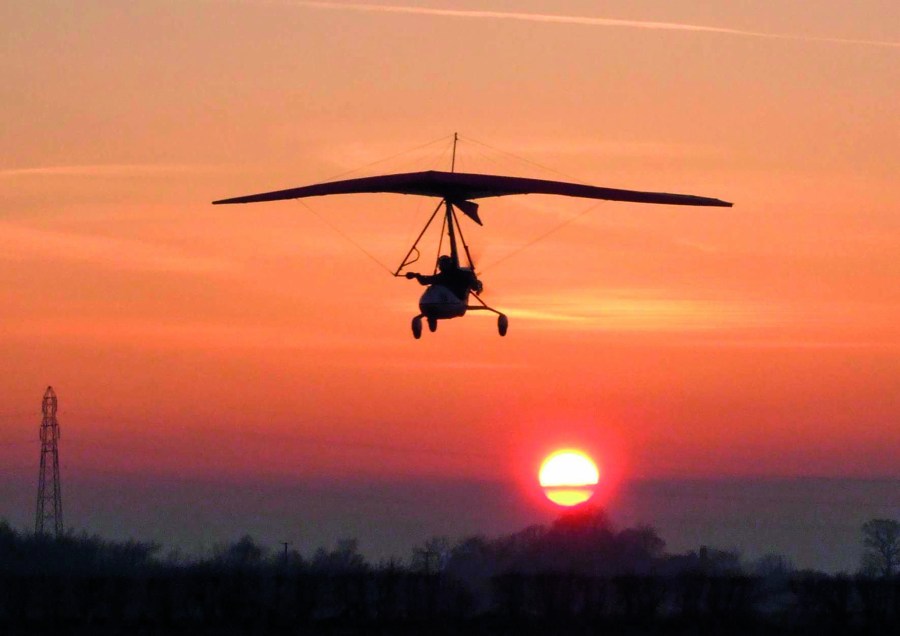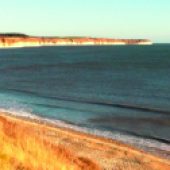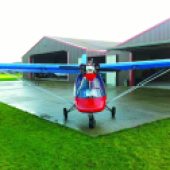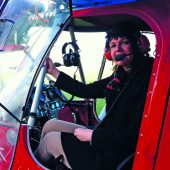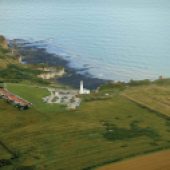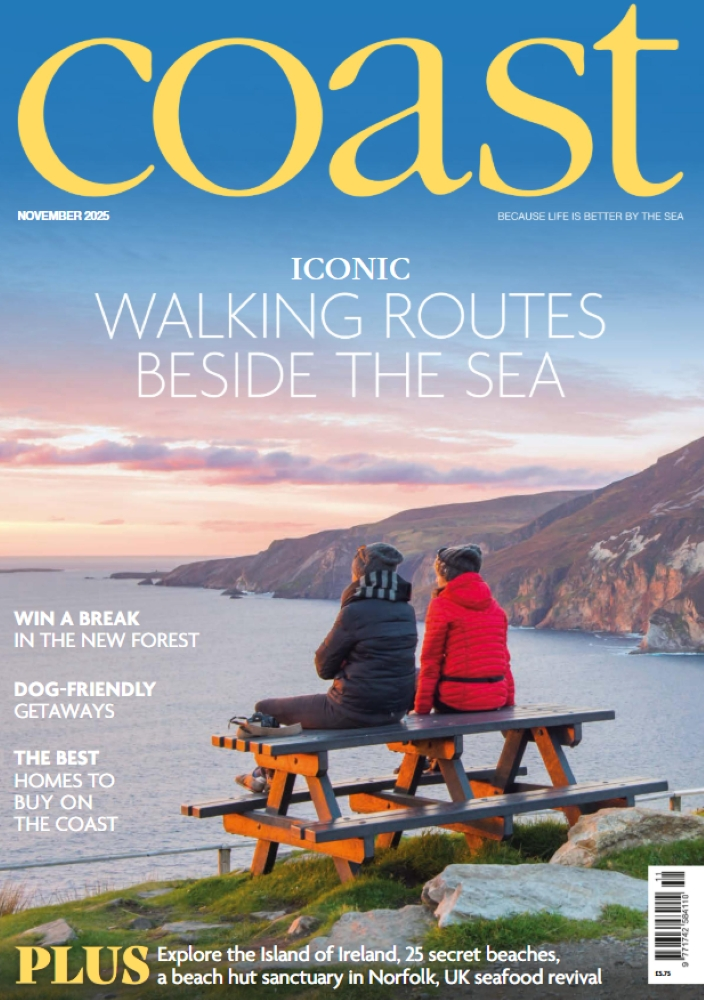Tina Walsh heads to Beverley Airfield for a morning of microlight flying, taking in the jaw-dropping marine landscape from the air
Quintessentially English seaside resorts, dramatic chalk cliffs and mile after mile of wide, sandy beaches: the East Yorkshire coast has them all. And what better way to see it than from the air? Rob McKellar and his wife Deborah, who run RM Aviation, have been teaching would-be pilots how to fly microlights – ultra-light miniature aircraft – over this eye-popping marine landscape from Hull Aero Club for the past 12 years.
Microlighting took off (no pun intended) in the late 1970s and early 80s on the back of the hang-gliding craze. There are now around 3000 aircraft in the UK, according to the British Microlight Aircraft Association, which itself has more than 3500 members.
My flight today, a round-trip of about 30 miles, will take me from Rob and Deborah’s base at Beverley Airfield, eastwards to the coast at Hornsea and north towards Flamborough Head. Together with its surrounding eight miles of white chalk cliffs, Flamborough Head is one of the area’s most iconic natural features: a 400-feet-high promontory jutting out into the North Sea. The cliffs, a Site of Special Scientific Interest (SSSI), attract huge colonies of guillemots, razorbills and kittiwakes.
As a child, I used to love coming here, especially exploring beautiful Thornwick Bay on the north side of Flamborough Head, with its mythical-looking sea arch, rockpools and secret coves. Right now, it looks a bit cold for paddling, but I can’t wait to get a bird’s eye view of these bygone holiday haunts.
10AM WINDY CITY
I meet Rob outside the church in the village of Leven, just down the road from Hull Aero Club. We drive down a dirt track for about a mile, with the wide, flat expanse of East Yorkshire spread out around us, under a grey blanket of sky. It doesn’t look much like flying weather, especially in something as tiny as a microlight, but Rob tells me that we’ll be taking a sturdier ‘fixed wing’ version, because of the cross wind.
10.30AM THE HULL BLITZ
And it’s a bitterly cold cross wind. Thankfully, it’s only a short hop from Rob’s van to the clubhouse, where a handful of members are sitting around chatting and warming themselves on Thermoses of tea. While Rob goes off to fetch the logbook (every flight has to be recorded), I look at the walls, covered with photos of World War Two bombers. ‘They called it the Hull Blitz,’ says one of the group, an elderly man who looks like he could have flown one himself. ‘After London, Hull was the most bombed city in the UK because of its strategic position as a port.’
11AM NEVER TOO OLD TO LEARN
Before we board our flight, Rob runs through a few basics. I learn that there are three main types of microlight, of which he operates two: the aforementioned fixed wing, which looks like a cross between a helicopter and a very small plane, and the flexwing, similar to a hang-glider with a two-person trike suspended underneath. Seemingly, you’re never too old to learn to fly one. Rob’s oldest student was a 96-year-old man who had flown in the war, and he has an 86-year-old training for his pilot’s licence.
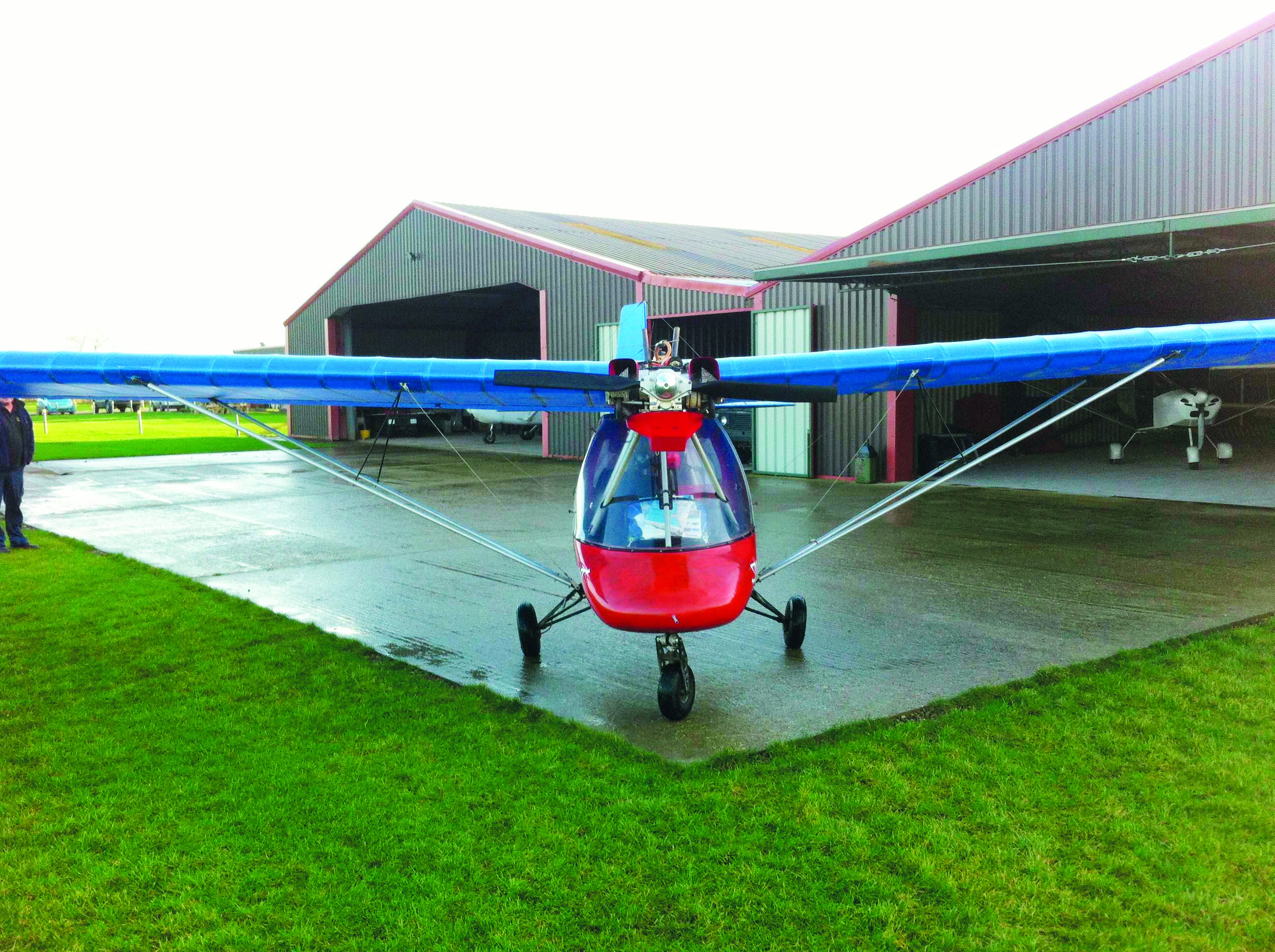
11.30AM ALL ABOARD
Now it’s my turn. The diminutive flying machine is sitting on the Tarmac, its shiny red body and cobalt-blue wings glinting in the sunshine that’s suddenly appeared. I go round to the passenger side and wait for instructions. ‘It’s a bit difficult to get in but there’s a knack to it,’ says Rob. I follow his orders, lifting my right leg into the carriage and sliding my foot down on to the rudders while grasping the metal bar over the door frame. I lift up my other leg, haul myself up and wriggle into the seat, in what I hope isn’t too ungainly a fashion.
12PM GROUND CONTROL
There’s not a lot of room to manoeuvre, but I get strapped in and Rob takes his place at the controls beside me, before running through a take-off check list. When he’s sure that everything – brakes, throttle, radio, fuel pump – is in working order, he hands me a pair of bright-red headphones, shouts to warn people that he’s starting the propeller and fires up the engine.
12.30PM COMMENCING COUNTDOWN
A few more pre-flight checks, including a rundown of the flight instruments, and the engine starts to warm up. Rob tells me we’ll be flying at around 2000 feet and 60mph, and jokes about doing some aerobatics and loop-the-loops. At least, I hope he’s joking. He revs up the engine, radios the control office and we’re ready to start taxiing to the runway – in this case, a strip of field. A few minutes of juddering later and we’re at take-off point at the bottom of the field. ‘Ready?’ asks Rob, as he turns the yoke (steering wheel, to you and me) and opens the throttle.
12.45PM WE HAVE LIFT OFF
My heart’s in my mouth as the microlight hurtles along, bumping and bouncing over the uneven surface. But we’re soon airborne, and I begin to relax as Rob starts banking expertly to the right towards the East Yorkshire coastline. We fly towards Hornsea, home of the late Hornsea Pottery company, whose distinctive mugs, casserole dishes and teapots used to grace my mum’s kitchen in the 1970s and can now be found in vintage shops up and down the country.
1PM HARBOUR TOWN
We’re flying over Hornsea Mere, Yorkshire’s largest freshwater lake, popular with bird-watchers, sailors and rowers. Bearing left to follow the coastline, Rob points out the disused runway at the village of Carnaby, where stricken fighter jets used to land during the war. At Bridlington, the fishing boats and trawlers are all neatly lined up in the harbour, appearing toy-like from this height.
1.15PM TO THE LIGHTHOUSE
Over to our right, the dramatic curve of Flamborough Head looms into view. I look down at the headland and see Flamborough’s two lighthouses. The first, a monolithic white chalk structure, was built in 1669 and is England’s oldest standing lighthouse. The second, nearer the cliff edge, was completed in 1806 and is open for guided tours from mid-April to the end of September.
1.30PM STEER IT UP
We’re homeward bound now and Rob asks me if I’d like to take a turn at the controls on my side of the aircraft. Would I! It takes a minimum of 25 hours’ flying time to qualify for a microlight licence, so I won’t be walking off with any certificates today, but I’m not doing anything more complicated than using the joystick and rudder pedals. Rob tells me to push down gently on the rudders and slowly ease off. This adjusts the aircraft’s height and the nose bobs up and down accordingly. ‘It’s one of the first things people learn,’ he says.
1.45PM DOWN TO EARTH
Rob takes over again just as the wind picks up. I ask him if he’s ever had any engine failures. ‘Only six,’ he replies. In the – hopefully unlikely – event we have one today, we’ll apparently glide back down to earth in much the same way as a hang-glider. Thankfully, we don’t, and we’re back on terra firma, and the enveloping warmth of the clubhouse, before I’ve had time to fully digest what he’s just said. But if there’s an aeronautical equivalent of sea legs, I think I’ve just acquired them, as I’d love to do it again – this time with no cross wind and in the even tinier flexwing.
RM Aviation Microlight Flying School, Beverley Airfield, Linley Hill, Leven, Beverley, East Yorkshire HU17 5LT. (07881 828514, rmaviation.co.uk).
ASK THE PROS
Rob Grinwood received a bursary to learn to fly from the British Microlight Aircraft Association when he was 16 and has been flying for more than 20 years. He’s won gold medals in many national and international competitions.
‘I first won a gold medal in the 2004 European Microlight Championships in Hungary at 23 years old. Since then I’ve won three European gold medals and four World Championships. I’m hoping to defend my title in August as part of the British team in the World Championships in Hungary. The thing I love most is the sense of freedom and the fact that you’re unrestricted in where you fly. I’ve flown all over the UK and Europe.’ Visit exodusairsports.co.uk.
NEED TO KNOW
HOW TO GET STARTED
For more information on microlighting, contact the British Microlight Aircraft Association (bmaa.org). There are other good coastal flying spots in Lancashire, Edinburgh, the Medway Estuary and Cromer in Norfolk. Once you have a licence you can fly anywhere in the UK, as well as take passengers and compete in national competitions.
HOW TO GET THERE
First Transpennine Express (tpexpress.co.uk) runs trains from Leeds to Hull, and Northern Rail (northernrail.org) from Hull to Bridlington. The journey time from Leeds is around an hour and 30 minutes. East Yorkshire Motor Services (eyms.co.uk) runs a bus service from Bridlington to Leven, which takes about an hour. Leven is off the A165.
WHERE TO STAY
The Villa Bridlington (01262 601786, thevillabridlington.co.uk) is a B&B in a sturdy Victorian terrace about five minutes’ walk from the seafront, with three rooms decorated in neutral colours, offering modern en-suite facilities, flat-screen TVs and DVD players. There’s a breakfast room/lounge and small licensed bar area. Spa treatments are also available if booked in advance. Rooms (adults only) start at £34 per person per night, including full English or Continental breakfast.
WHAT IT COSTS
With RM Aviation, an hour’s introductory lesson costs £110, £100 thereafter; £60 for a 30-minute lesson. Club membership is £150 a year. Microlights sell from around £1500 for a second-hand flexwing and up to £80,000 for a top-of-the-range fixed wing.
Tina Walsh heads to Beverley Airfield for a morning of microlight flying, taking in the jaw-dropping marine landscape from the air
Quintessentially English seaside resorts, dramatic chalk cliffs and mile after mile of wide, sandy beaches: the East Yorkshire coast has them all. And what better way to see it than from the air? Rob McKellar and his wife Deborah, who run RM Aviation, have been teaching would-be pilots how to fly microlights – ultra-light miniature aircraft – over this eye-popping marine landscape from Hull Aero Club for the past 12 years.
Microlighting took off (no pun intended) in the late 1970s and early 80s on the back of the hang-gliding craze. There are now around 3000 aircraft in the UK, according to the British Microlight Aircraft Association, which itself has more than 3500 members.
My flight today, a round-trip of about 30 miles, will take me from Rob and Deborah’s base at Beverley Airfield, eastwards to the coast at Hornsea and north towards Flamborough Head. Together with its surrounding eight miles of white chalk cliffs, Flamborough Head is one of the area’s most iconic natural features: a 400-feet-high promontory jutting out into the North Sea. The cliffs, a Site of Special Scientific Interest (SSSI), attract huge colonies of guillemots, razorbills and kittiwakes.
As a child, I used to love coming here, especially exploring beautiful Thornwick Bay on the north side of Flamborough Head, with its mythical-looking sea arch, rockpools and secret coves. Right now, it looks a bit cold for paddling, but I can’t wait to get a bird’s eye view of these bygone holiday haunts.
10AM WINDY CITY
I meet Rob outside the church in the village of Leven, just down the road from Hull Aero Club. We drive down a dirt track for about a mile, with the wide, flat expanse of East Yorkshire spread out around us, under a grey blanket of sky. It doesn’t look much like flying weather, especially in something as tiny as a microlight, but Rob tells me that we’ll be taking a sturdier ‘fixed wing’ version, because of the cross wind.
10.30AM THE HULL BLITZ
And it’s a bitterly cold cross wind. Thankfully, it’s only a short hop from Rob’s van to the clubhouse, where a handful of members are sitting around chatting and warming themselves on Thermoses of tea. While Rob goes off to fetch the logbook (every flight has to be recorded), I look at the walls, covered with photos of World War Two bombers. ‘They called it the Hull Blitz,’ says one of the group, an elderly man who looks like he could have flown one himself. ‘After London, Hull was the most bombed city in the UK because of its strategic position as a port.’
11AM NEVER TOO OLD TO LEARN
Before we board our flight, Rob runs through a few basics. I learn that there are three main types of microlight, of which he operates two: the aforementioned fixed wing, which looks like a cross between a helicopter and a very small plane, and the flexwing, similar to a hang-glider with a two-person trike suspended underneath. Seemingly, you’re never too old to learn to fly one. Rob’s oldest student was a 96-year-old man who had flown in the war, and he has an 86-year-old training for his pilot’s licence.

11.30AM ALL ABOARD
Now it’s my turn. The diminutive flying machine is sitting on the Tarmac, its shiny red body and cobalt-blue wings glinting in the sunshine that’s suddenly appeared. I go round to the passenger side and wait for instructions. ‘It’s a bit difficult to get in but there’s a knack to it,’ says Rob. I follow his orders, lifting my right leg into the carriage and sliding my foot down on to the rudders while grasping the metal bar over the door frame. I lift up my other leg, haul myself up and wriggle into the seat, in what I hope isn’t too ungainly a fashion.
12PM GROUND CONTROL
There’s not a lot of room to manoeuvre, but I get strapped in and Rob takes his place at the controls beside me, before running through a take-off check list. When he’s sure that everything – brakes, throttle, radio, fuel pump – is in working order, he hands me a pair of bright-red headphones, shouts to warn people that he’s starting the propeller and fires up the engine.
12.30PM COMMENCING COUNTDOWN
A few more pre-flight checks, including a rundown of the flight instruments, and the engine starts to warm up. Rob tells me we’ll be flying at around 2000 feet and 60mph, and jokes about doing some aerobatics and loop-the-loops. At least, I hope he’s joking. He revs up the engine, radios the control office and we’re ready to start taxiing to the runway – in this case, a strip of field. A few minutes of juddering later and we’re at take-off point at the bottom of the field. ‘Ready?’ asks Rob, as he turns the yoke (steering wheel, to you and me) and opens the throttle.
12.45PM WE HAVE LIFT OFF
My heart’s in my mouth as the microlight hurtles along, bumping and bouncing over the uneven surface. But we’re soon airborne, and I begin to relax as Rob starts banking expertly to the right towards the East Yorkshire coastline. We fly towards Hornsea, home of the late Hornsea Pottery company, whose distinctive mugs, casserole dishes and teapots used to grace my mum’s kitchen in the 1970s and can now be found in vintage shops up and down the country.
1PM HARBOUR TOWN
We’re flying over Hornsea Mere, Yorkshire’s largest freshwater lake, popular with bird-watchers, sailors and rowers. Bearing left to follow the coastline, Rob points out the disused runway at the village of Carnaby, where stricken fighter jets used to land during the war. At Bridlington, the fishing boats and trawlers are all neatly lined up in the harbour, appearing toy-like from this height.
1.15PM TO THE LIGHTHOUSE
Over to our right, the dramatic curve of Flamborough Head looms into view. I look down at the headland and see Flamborough’s two lighthouses. The first, a monolithic white chalk structure, was built in 1669 and is England’s oldest standing lighthouse. The second, nearer the cliff edge, was completed in 1806 and is open for guided tours from mid-April to the end of September.
1.30PM STEER IT UP
We’re homeward bound now and Rob asks me if I’d like to take a turn at the controls on my side of the aircraft. Would I! It takes a minimum of 25 hours’ flying time to qualify for a microlight licence, so I won’t be walking off with any certificates today, but I’m not doing anything more complicated than using the joystick and rudder pedals. Rob tells me to push down gently on the rudders and slowly ease off. This adjusts the aircraft’s height and the nose bobs up and down accordingly. ‘It’s one of the first things people learn,’ he says.
1.45PM DOWN TO EARTH
Rob takes over again just as the wind picks up. I ask him if he’s ever had any engine failures. ‘Only six,’ he replies. In the – hopefully unlikely – event we have one today, we’ll apparently glide back down to earth in much the same way as a hang-glider. Thankfully, we don’t, and we’re back on terra firma, and the enveloping warmth of the clubhouse, before I’ve had time to fully digest what he’s just said. But if there’s an aeronautical equivalent of sea legs, I think I’ve just acquired them, as I’d love to do it again – this time with no cross wind and in the even tinier flexwing.
RM Aviation Microlight Flying School, Beverley Airfield, Linley Hill, Leven, Beverley, East Yorkshire HU17 5LT. (07881 828514, rmaviation.co.uk).
ASK THE PROS
Rob Grinwood received a bursary to learn to fly from the British Microlight Aircraft Association when he was 16 and has been flying for more than 20 years. He’s won gold medals in many national and international competitions.
‘I first won a gold medal in the 2004 European Microlight Championships in Hungary at 23 years old. Since then I’ve won three European gold medals and four World Championships. I’m hoping to defend my title in August as part of the British team in the World Championships in Hungary. The thing I love most is the sense of freedom and the fact that you’re unrestricted in where you fly. I’ve flown all over the UK and Europe.’ Visit exodusairsports.co.uk.
NEED TO KNOW
HOW TO GET STARTED
For more information on microlighting, contact the British Microlight Aircraft Association (bmaa.org). There are other good coastal flying spots in Lancashire, Edinburgh, the Medway Estuary and Cromer in Norfolk. Once you have a licence you can fly anywhere in the UK, as well as take passengers and compete in national competitions.
HOW TO GET THERE
First Transpennine Express (tpexpress.co.uk) runs trains from Leeds to Hull, and Northern Rail (northernrail.org) from Hull to Bridlington. The journey time from Leeds is around an hour and 30 minutes. East Yorkshire Motor Services (eyms.co.uk) runs a bus service from Bridlington to Leven, which takes about an hour. Leven is off the A165.
WHERE TO STAY
The Villa Bridlington (01262 601786, thevillabridlington.co.uk) is a B&B in a sturdy Victorian terrace about five minutes’ walk from the seafront, with three rooms decorated in neutral colours, offering modern en-suite facilities, flat-screen TVs and DVD players. There’s a breakfast room/lounge and small licensed bar area. Spa treatments are also available if booked in advance. Rooms (adults only) start at £34 per person per night, including full English or Continental breakfast.
WHAT IT COSTS
With RM Aviation, an hour’s introductory lesson costs £110, £100 thereafter; £60 for a 30-minute lesson. Club membership is £150 a year. Microlights sell from around £1500 for a second-hand flexwing and up to £80,000 for a top-of-the-range fixed wing.

